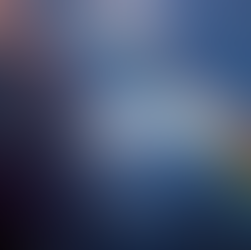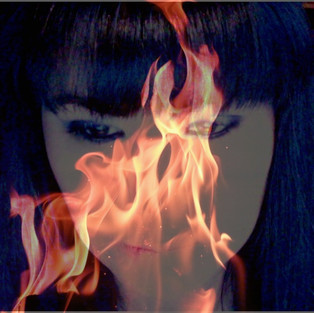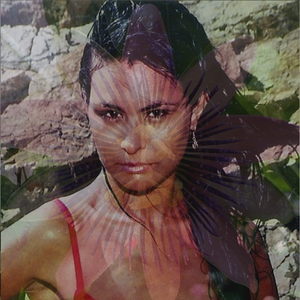Ever since mid-summer of this current year, I've felt my entire body as though it was a pendulum. I’ve been unable to quiet my soul as I seem to be swinging in the ether, to and fro, ungrounded, untethered, dwelling inside digital palimpsests: either hoping or dreading to be read.
I've felt at ease, occasionally, when, for example, I worked in my garden. But since the earth beneath my feet seems oftentimes, to be quaking, I'm barely able to stand my ground. What's worse, my thumb gives up on me, and it trembles--my thumb isn't green these days, but blackened in ink. During difficult days though, is when I run away into the worlds inside books, and when I endeavor in creating my own worlds. Reading and writing become a means to shape pain into words, and words into hope, and so reimagining an outer world where I can find me in my home becomes a possibility. My survival instinct coaxes me to seek re-emergence. "It should be simple," I say to my other self, (the one in the mirror), "it's just about connecting. Inside and outside."
But these days, it's hard to connect, despite my best efforts. I'm a pendulum, rarely touching down and utterly stained in ink. I do remind myself though, that I too feel grounded when I’m teaching. Perhaps, because I teach inspired in the principles of ecology, which are grounded in dimensions of resilience, summoning [me] to a true call to action. I see what I must seek to restore me, my life, and while committed to show my students the path to health, kindness, and justice, I practice mine. A path to love, so we may connect with all in the ecosystems we inhabit, where we act and interact. And even where urban and wild spaces collide, we ought to coalesce with them instead, fluidly.

Today, I find inspiration in the shape of a scar. I imagine that polka dots of blood can be read like musical notes spilling sounds over the lines of a pentagram. Another scar might take flight, gracefully and sinuously dancing on the sky, like a flock of birds migrating to a sunnier place to prosper, to mate. A scar might even merge with the light, and this is how a wound might teach us to appreciate being alive. Wounds might teach us to keep on seeking the light. And so I hope this to be the case for the many of us wanting to remain wild even when wounded; wishing to be wooed by desire, by passion, and by love.
And this morning, I stir my imagination reading a poem by W.S. Merwin, "Day Without a Name," maybe for the hundredth time, and it still sounds as if read for the very first time--because in it, I find something that I've thought I'd lost. And in it, I meet someone else reading the same. Feeling the same. Writing the same. Being the same. After all, a page is a place where writers and readers meet and where they mate, not with their bodies, but with their words. A page is so much a place that, sometimes a sheet is a bedsheet, or a sheet is a pentagram. And on it, we breathe, we bleed ink, we heal, we make love: writing reveals itself before our eyes. Awe.
Over the weekend of September 6-8, my husband Federico Ramos and I drove to Tehachapi for a unique visionary adventure to sightsee Native Americans' rock art in secret and sacred sites, guided by David Scott Whitley. Hence, my first essay Tracing Lines Between Stars: My Shamanistic Happenstance with David S. Whitley. Ever since, I've been writing and reading about Bob Rabbit, a shaman and a rainmaker whose pictographs impacted me the most, as hinted on the video of my poem a fix of ink, filmed at Coso Junction. I've been thinking a lot about the meaning of some rituals, and ceremonies, rites of passage, about resilience, and about the power of love. Reading and writing always affect me to think about being and place. This shouldn't be a surprise, but I love that it always is!
When I was hiking the dry and hot chaparral of Coso Junction spellbound by Native Americans' Rock Art, I had many an epiphany, and I blended with the space, feeling my skin as another shade of the landscape. But something else happened that reminded me of how we're always in contact with all the elements constituting our surroundings. Sometimes, we come in such a close contact with surfaces that we collide. Friction isn't fusion, so I know that at some point during the hiking, I disconnected, and I hurt my calf albeit in a mysterious way.

The happening was uncanny and more so to sight the strange scratches on my leg about an hour later when I was already walking an urban space. I had not felt any physical pain until the instant when I discovered these piercings on my skin as though made by the thin but sharp claws of a wild creature. They too looked like tattooed lines as if stenciled by an artist, and the colors of my skin and the scratches mimicked the place where I have walked upon, the chaparral lands of Coso Range.
As I looked down at my leg trying to remember when the wound could have happened, the lines on my skin started to burn as though internally ignited, and tiny blood dots burst, albeit timidly, in slow motion. And for a few seconds, these small spots remained caught on my skin, like raindrops ornamenting bare twigs of trees. But I soon realized that the land of the desert had impregnated me. My skin had the color of this land. I had merged with the rocks, and these injuries were my own pictographs. I wanted to decipher their meaning, as much as Dave had devoted his life to understand the language of shamans and the red clay traces made with brushes made of sage, and lines sketched by fingers left upon these rocks.

A poem by the hypnotizing Arthur Rimbaud begins with this line "My turn now. The story of one of my insanities," in which he describes the power of inspiration and the imagination. Like Rimbaud, I too "[invent] colors for the vowels! [and] I ma[k]e rules for the form and movement of every consonant, inventing rhythms from within me, a kind of poetry that all the senses would recognize." And like Rimbaud, I am the only one able to translate them into a page, as I strive to do in this my now, to write now, right now. The thing is that this urge to manifest my expression and experience onto the place of a page is, without fault, the constant seed for creativity as much as is it seed for my making sense of my insanity.

When I'm sad, angry or obsessed, I want to create a place where I can go away to forget about the sorrows and the horrors and the bleak tomorrows surrounding this real world that I inhabit. I go into my pages and stay there, breathing into it, as it reveals upon me beauties and truths that aren't at odds with my identity as is everything else out there. In my world, it's possible to "believe in every kind of magic," as Rimbaud says. But I don't want to stop believing that it's possible to find all kinds of magic in the real world. I want to connect with the outside world. Adapt to be part of something greater. Feel included in this world of such beautiful diversity without being forced to relinquish my identity.

Only that when I'm sad, when I grieve, when my heart is broken repeatedly within the span of a few weeks, it's challenging to want to be out there. And every time I see unkindness and injustice all around, which nowadays it's way too often, I'd rather run back to my pages. I'd rather turned my back to the world.
These are the times when I need the most to read and to write words that shape me with hope. To restore, and re-emerge, to be healthy, to stand my ground, to own my voice.
Indeed, my creative obsessions keep me craving for love and my gloominess at bay. I draw a poem shaped like a circle with words that I know most of my fellow writers share with me, like the words "overreacting," "obsession," "overwhelmed." In English to me, the phoneme of "awe" is the same as the phoneme of "o." But I'm "overthinking" the words that I use, the themes and leitmotifs of my story because I'm deep in. I'm [in] the story. In this world within.
Last night, an hour of insomnia turned into lucid dreaming, and I woke up dialoguing with my characters. They told me that people should breathe their own life into their story. I too interlace myself with the people of this world of my creation, to provide sinew and flesh and bone to their journey, birthing words from the womb of my mouth without revealing too bluntly their most inner spaces; and still make readers believe, imagining their own interiority instead of gawking into my characters'. And herein is when the necessity of finding a reader makes me want to come out to the real world, dreaming that my pages will be read by blue, and by green, and by brown, and by black eyes. No matter where my readers might be, I dream them looking into my pages, making them believe that all kinds of magic are possible. I'll connect with them, via words, and they'll read themselves within.
Sometimes, when I am scared to fail, to be rejected, to feel lonely, and I see my odyssey filled with odds, I dim down. But my creative flow doesn't stop. Only that I become a river flowing in the night, when only its sounds can be identified, but not its body of water. I'm brown, like the river of my country of birth--a developmental nation, as some would label Uruguay. Thus, I'm invisible and brown as is el Río de la Plata. Almost as invisible as my scars blended in volcanic sand knowing that too long ago they were embers about to be forever extinguished.
Sometimes, I dance at the beach to meditate or conjure spells, so people are drawn to me and wish to read my words. And I believe it will happen because yesterday the Pacific ocean answered my prayers by leaving at my feet clear signs crafted as clay. And I felt the turbulence of sand mixing its millions of grains twirling around my legs, a whirlpool of ocean water following the rhythm of my dancing feet following the rhythm of Rachael Yamagata's "I've Known for Years." And all the while, the wind was blowing above the surface of the ocean and over my skin, leaving traces of salt and layers of dew. And as the waves receded, the sand was shaped as elongations of my toes like tree roots, of my fingers inked.
Some other times, like when I observe rare meteorological occurrences like rain and sun above me, I'm inspired, because I know that next, I will sight a rainbow. So, a whole new story sprouts from my mouth in the shape of a sunflower, and I even see endings that never end—endless finalities like Roland Barthes would say, which are about cycles, and pleasure and pain, reminding us that we are human beings, as flawed as fatigued, and as imaginative as resourceful, because we're here and we're near. Beings sharing place. Transmuting.
A writer told me that I have a near preternatural knack for finding poetry in the ugliest and most unexpected of spaces. And it's true, and so, when I face something ugly or unpleasant or unbearably painful, I channel through me all the negative energy transforming it into positive energy. Just like the crystal body of an amethyst would do.
Amethyst is my crystal, and when I meditate, I feel its power coming to me as light and heat, as if it had been put on fire just before nesting inside my hand. Amethyst is known for its gorgeous purple, and its rhombohedral formations contain iron. I believe that the iron endows it, and me, with pure strength, even in its diaphaneity. Some archeologists assert that if amethyst is afire in around 300-400°C (572°F), its violet fades away transmuting into a golden amber. So, it becomes another crystal, Citrine, with which I also meditate, that symbolizes restoration and strength, clearing [my] inner visions and endowing me with foresight. But amethyst is my birthstone and coincidentally, it comes from my homeland, Uruguay. Meditating with Amethyst and Citrine crystals make me feel at home even in foreign lands. And then, I remember that crystals are Earth's offerings to us, fragments of our planet's crust, treasures from beneath whichever lands we walk.
Surely, I've no internal GPS, but I know West and South, the former by my city of choice, Santa Monica, the latter by my city of origin, Montevideo. I believe that I can guide myself stargazing, and even in the darkest of nights, I believe that the ocean will signpost the way of stormy seas with noctiluca, and I will stand on top of a mountain and shout my identity to the wind, and I'll be heard, I'll be seen.
I oftentimes find solace in my garden. I love flowers and can lose myself for long minutes caught in their every detail, sinking my fingers into the soil, pruning withered leaves, smelling their scent up close. Being in my garden gives me a sense of home as though it didn't matter whether my garden were geographically located in the house of my chosen city, or if it were in my homeland. There are two flowers that I've seen in Santa Monica, which are typical of regions surrounding Uruguay: la flor del Ceibo, known in English as Cockspur Coral, and la flor del Mburucujá, known in US as Passionflower. Yet, the former is my country's national symbol, and the second is representative of a dying language and a South American culture, of the Native American known as Guaraníes, and the Charrúas, from whom I'm proud descendant (according to my DNA test). San Vicente Boulevard in Santa Monica is divided by patches of grass and Ceibo Trees, and frequently, when I drive by, I feel I'm on las calles de Montevideo. And when I've sight Mburucujá flowers, I find me. I'm one with it, and I'm no longer an other, alone, untethered, lost. I am home.
































コメント